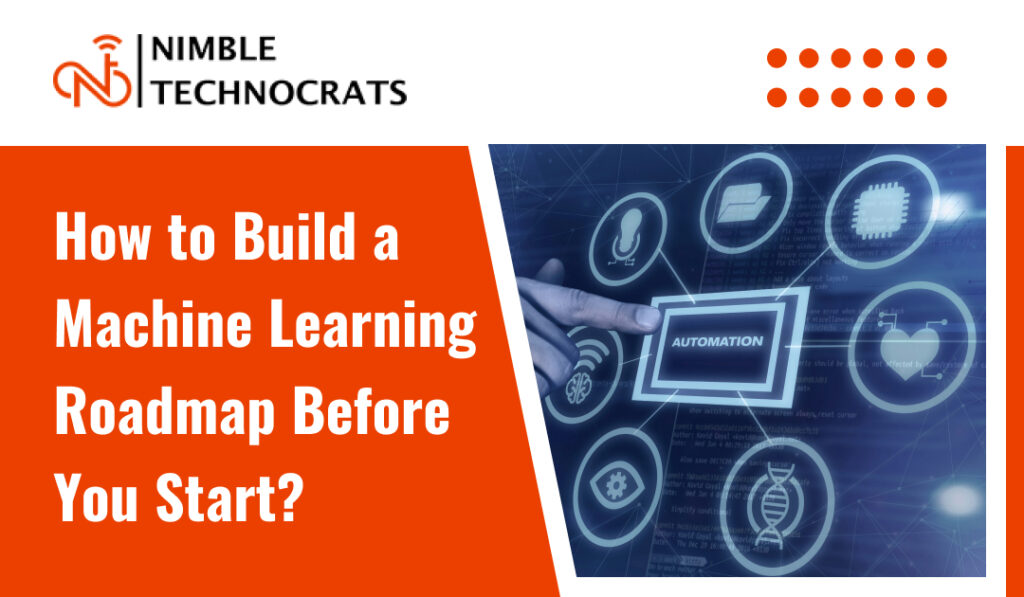How to Build a Machine Learning Roadmap Before You Start?
This post is especially for those who want to start a machine learning journey but are confused about where to start first. The blog will share a roadmap to machine learning for beginners. We’ll share important aspects that you need to learn about machine learning and artificial intelligence. Continue reading this blog, to know more about the strategy to learn machine learning.
Basic Roadmap for Machine Learning
Machine learning allows computers to learn and improve based on previous experience or examples. Image and speech recognition, natural language processing, recommendation systems, predictive analytics, anomaly detection, and many other applications are possible. It continues to evolve as more advanced algorithms, higher computing power, and large datasets become available. Take a look at the below section to learn the machine learning roadmap for beginners:
Mathematics and Statistics
To know how machine learning algorithms work, you must understand linear algebra, probability, calculus, and statistics.
Linear algebra: Vectors, matrices and operations.
Calculus: Differentiation, optimization, and integration.
Probability theory and statistics: Distributions, hypothesis testing, random variables, and regression.
Learn Programming
Make sure to learn the basics of Python programming language and its libraries such as Pandas, NumPy, and Matplotlib. In addition to this, learn the programming language R. You must know about object-oriented programming principles. All this is included in a roadmap to learn machine learning.
Foundation of Machine Learning
Ensure to work through tutorials that cover supervised learning that include linear regression, decision trees, logistic regression, support vector machines (SVM), and random forests. Unsupervised learning includes dimensionality reduction techniques and clustering algorithms.
In-Depth Learning
Roadmap for machine learning makes you dig deeper to learn neural networks, and frameworks, such as TensorFlow or PyTorch. Learn about:
Convolutional Neural Networks (CNN): Object detection, image classification, and convolutional layers.
Recurrent Neural Networks (RNN): Text generation, sequential data modelling, and LSTM/GRU cells.
Generative Adversarial Networks (GAN): Image synthesis and synthetic data generation.
Advanced Machine Learning Techniques
When learning advanced machine learning techniques, you must understand everything about:
Ensemble methods: Boosting, bagging and stacking.
Regularization techniques: L1 and L2 regularization, batch normalization, and dropout.
Feature engineering: Feature selection, extraction, and transformation.
Reinforcement learning: Q-learning, Markov decision processes, and policy gradients.
Model Deployment and Production
Make sure to understand the fundamentals of model deployment that includes packaging model for production, containerization and cloud platforms. You need to know how to build APIs with frameworks such as Django or Flask. Get a basic idea of how to monitor and maintain models, such as continuous integration/continuous deployment (CI/CD) pipelines, and updating models.
Don’t Stop Learning
The road map for machine learning demands not to stop learning. Keep yourself updated with new research papers, machine learning communities, and conferences. You can also collaborate with other machine learning practitioners to learn from their experiences.
Apply Machine Learning to Real Projects
After following the machine learning road map, you need to implement machine learning in real projects. Finally, working on end-to-end projects that mirror real-world applications is the best approach to improving your ML skills. Identify challenges that interest you and create solutions utilising the ML techniques you’ve studied. The process of transforming ideas into working prototypes can help you gain practical experience faster. Make a point of highlighting these projects in your portfolio. The following are some examples of machine learning projects could include:
An NLP model to analyse customer sentiment from support requests
A computer vision system to address problems in medical imaging scans
A time series forecasting technique for anticipating future sales
A recommender system that serves personalised material to users.
Taking on projects that interest you will keep you motivated while you improve your applied ML skills. And you’ll have tangible results to show for your efforts. It may feel like there are numerous concepts that you need to understand when start learning machine learning. However, take it step-by-step and understand each concept with full focus and enjoy bringing machine learning to life through this machine learning road map.
Conclusion
With this roadmap for machine learning, you can develop ML skills. Moreover, if you are interested in learning any programming language, you can contact Nimble Technocrats.
Other Useful Links:-
How to Build a Machine Learning Roadmap Before You Start? Read More »
